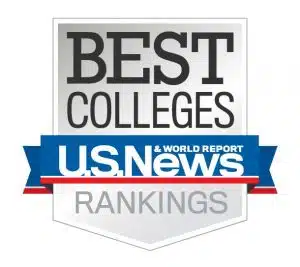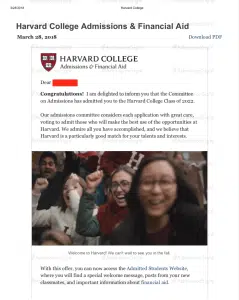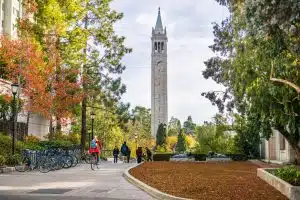Harvard Acceptance Rate: Admissions Statistics
What is Harvard’s Acceptance Rate?
The Harvard acceptance rate for the Class of 2027 was 3.41 percent, signifying the second-lowest rate in the university’s history.
Harvard University welcomed a total of 1,966 students out of 56,937 applicants were accepted, resulting in an acceptance rate of 3.41 percent. This year’s applicant pool saw a decrease of 4,283, or 7 percent, from the 61,220 who applied for the Class of 2026, which may suggest a shift towards normalization following the spike in applications seen after the pandemic.
Harvard’s historically low acceptance rate reflects not just the university’s elite status but also the sheer level of excellence expected from candidates. The early action program at Harvard also remains a competitive route, with 722 students securing their places in December.
Harvard Early Action and Early Decision Acceptance Rates
Harvard has both Early Action (EA) and Regular Decision (RD) options for first-year applicants.
For the Class of 2027, Harvard College accepted 722 students through the Early Action (EA) program from a pool of 9,553 applicants, resulting in an acceptance rate of 7.56%. The overall acceptance rate for the Class of 2027 was 3.4%.
Here are the Early Action (EA) acceptance rates for Harvard for the last five years:
| Class | EA |
| 2027 | 7.6% |
| 2026 | 7.9% |
| 2025 | 7.4% |
| 2024 | 13.9% |
| 2023 | 13.4% |
Harvard Acceptance Rate Trends
In the past ten years, Harvard University has seen its acceptance rate steadily decline, reflecting a trend towards greater selectivity.
From a rate that hovered above 5% a decade ago to now dipping below 4%, this trajectory showcases the intensifying competition for a place within its prestigious halls as the institution continues to attract a growing number of high-caliber applicants each year.
| Admission Year | Total Number of Applications Received | Acceptance Rate |
| 2023 | 56,937 | 3.41% |
| 2022 | 61,220 | 3.19% |
| 2021 | 57,435 | 3.43% |
| 2020 | 40,248 | 4.92% |
| 2019 | 43,330 | 4.50% |
| 2018 | 42,749 | 4.59% |
| 2017 | 39,506 | 5.20% |
| 2016 | 39,041 | 5.22% |
| 2015 | 37,305 | 5.33% |
| 2014 | 34,295 | 5.90% |
| 2013 | 35,023 | 5.80% |
For prospective students aiming to join the ranks of Harvard admits, these statistics underscore the importance of a standout application that showcases exceptional academic achievements, extracurricular commitments, and personal strengths.
Harvard Admissions Statistics
Harvard College’s selective admissions process for the Class of 2027 has culminated with 1,966 successful applicants out of a pool of 56,937, reflecting a highly competitive 3.41% Harvard acceptance rate.
Of the accepted students, an impressive 84 percent have committed to attending Harvard in the fall, indicating a continuation of the university’s strong appeal among top-tier students.
This high yield has resulted in only a select number of additional admissions from the waiting list. Specifically, according to Harvard’s website, 27 individuals were granted admission from the waitlist to join the Class of 2027.
Additionally, Harvard welcomed 13 transfer students, adding to the diversity and richness of the Harvard community.
Notably, 19 percent of the newly admitted students are recipients of federal Pell grants, suggesting a significant representation from lower-income households. Nearly 20 percent are pioneers in their families to attend college, although these figures are a slight decrease from the previous year.
Overview of Harvard University

Harvard University is recognized globally for its unparalleled commitment to higher education and research. Established in 1636 and located in Cambridge, Massachusetts, Harvard is the United States’ oldest higher education institution and a member of the prestigious Ivy League.
Across its sprawling campus and through its 12 degree-granting schools, Harvard offers a breadth of rigorous academic programs, from its world-renowned Law School and Business School to the pioneering Medical School and the Faculty of Arts and Sciences.
The university is a treasure trove of resources, with the largest academic library system in the world, extensive museums like the Harvard Art Museums, and cutting-edge research facilities. Its faculty includes Nobel laureates, Fields Medalists, and Pulitzer Prize winners who lead their fields in research and innovation.
Harvard’s influence extends globally through its vast alumni network, which includes heads of state, Nobel laureates, and leaders in various sectors. With a commitment to excellence, Harvard continually evolves, embracing new challenges and fostering an environment where future leaders are nurtured through academic rigor, research opportunities, and a diverse and inclusive community.
Harvard Demographics
The group of students accepted into Harvard comes from diverse cultural, economic, and geographical backgrounds, mirroring a small-scale version of the global population. Students come from every corner of the United States and from 101 other countries, making up a truly international community.
In terms of racial diversity, the admitted class includes the following:
- Asian American: 29.9%
- African American/Black: 15.3%
- Latinx: 11.3%
- Native American: 2.2%
- Native Hawaiian: 0.5%
Women form a majority at 53.6 percent of the class, underscoring Harvard’s commitment to gender diversity.
The class’s geographical composition is broad, with a significant presence from the Middle Atlantic and New England and a noteworthy international representation:
- New England: 15.9%
- Middle Atlantic: 22.1%
- South: 17.4%
- Midwest: 10.2%
- Central: 1.5%
- Mountain: 3.4%
- Pacific: 13.8%
- Territories: 0.3%
- International: 15.4%
Harvard’s Class of 2027 exemplifies the institution’s sustained allure and its commitment to fostering a dynamic and diverse academic environment. As these young scholars prepare to embark on their collegiate journey, they embody the promise and potential that Harvard continues to cultivate year after year.
SAT/ACT Scores for Harvard Admits
In navigating the Harvard acceptance rate for the Class of 2027, it’s crucial to discuss the historical data that shows the competitive nature of admitted students’ academic credentials.
Since the Class of 2026, Harvard has allowed applicants to forgo submitting standardized test scores, acknowledging the ongoing limited access to testing sites resulting from the COVID-19 pandemic.
True to its comprehensive review process, Harvard evaluates each applicant on a variety of factors, not just test scores. This holistic approach takes into account a student’s achievements both inside and outside the classroom, including extracurricular participation, community service, work experience, and family duties.
Applicants who choose not to include standardized test scores with their application will be at no disadvantage during the admission review process.
Let’s examine the SAT/ACT scores for Harvard admits for the Class of 2026.
The average ACT scores for admitted students are as follows:
- 25th percentile score: 34
- 75th percentile score: 36
The average SAT Evidence-Based Reading and Writing scores for admitted students are as follows:
- 25th percentile score: 730
- 75th percentile score: 780
The average SAT Math scores for admitted students are as follows:
- 25th percentile score: 760
- 75th percentile score: 800
These statistics emphasize that while standardized tests are not mandatory, they have historically been one indicator of the academic prowess of Harvard’s student body.
What Harvard Looks For
When high school students envision their paths to prestigious universities, they often wonder what Harvard looks for. Yet, Harvard offers a transparent glimpse into their expectations, which can illuminate the path not just for its aspirants but also for those targeting similarly elite institutions.
Harvard’s admissions are holistic, considering a myriad of factors beyond academics. It’s not solely about having top grades and test scores; the university seeks individuals who show great potential for future societal contributions.
This potential can manifest in varied forms: from academic preparedness to unique talents, from leadership in extracurricular activities to the diversity of experiences.
Harvard emphasizes the importance of maximizing opportunities and available resources, a trait they expect students to carry forward into their collegiate and post-collegiate lives. As such, they encourage prospective students to focus on mastering key subjects and skills indicative of readiness for a rigorous liberal arts education.
The university underscores the value of a rigorous high school curriculum as a foundation for success in a challenging liberal arts environment. To this end, Harvard suggests a concentrated study in the following subjects:
- English: Four years, emphasizing comprehensive reading of global literary classics.
- Foreign Language: Four years of one language to foster deeper cultural understanding and communication skills.
- History: A minimum of two years, including American and European history, with a recommendation for an additional advanced course.
- Mathematics: Four years, with courses that encourage conceptual understanding and higher-order thinking.
- Science: Four years, covering physics, chemistry, and biology, and ideally one advanced course in these disciplines.
- Expository Writing: Regular practice to refine the ability to articulate complex ideas effectively.
It’s important to note the absence of specific subjects such as art and music does not imply their insignificance but rather focuses on areas with clear empirical support for college preparation.
Moreover, it’s worth noting that while advanced courses like calculus are not mandatory for admission, they can be beneficial for students with aspirations in fields such as engineering or computer science.
Harvard’s admissions team understands that every student’s situation is unique, with variables like school resources and personal interests playing a role in course selection. As such, they evaluate each applicant’s academic record in context, ensuring a fair and comprehensive review process.
In sum, Harvard seeks students who have challenged themselves with the most rigorous courses available to them, demonstrating a depth of knowledge and a capacity for critical thought. Yet, it’s the combination of academic prowess, extracurricular distinction, and personal qualities that completes the profile of a Harvard candidate.
Aspiring students should remember that while Harvard sets a high bar, the university’s approach is designed to identify potential in its many forms. They encourage applicants to pursue a high school education that not only prepares them for the academic challenges of college but also fosters a lifelong passion for learning and exploration.
How Hard Is It to Get Into Harvard?
How hard is it to get into Harvard? Harvard University stands as one of the most prestigious institutions in the world, a status that is reflected in its highly selective admissions process. With the lowest acceptance rate among the Ivy League schools, Harvard consistently sets the standard for exclusivity in higher education.
| Harvard University | 3.41% |
| Columbia University | 3.90% |
| Yale University | 4.35% |
| Brown University | 5.20% |
| Dartmouth College | 6.23% |
| University of Pennsylvania | Withheld |
| Princeton University | Withheld |
| Cornell University | Withheld |
This stringent selection process underscores the university’s commitment to fostering a community of exceptionally talented individuals. As applicants from all corners of the globe vie for a coveted spot within its historic halls, the competition remains intense.
Harvard’s rigorous standards and the sheer number of applicants make gaining admission a formidable challenge, one that requires not just academic excellence but a distinctive portfolio of accomplishments and potential contributions to the university’s vibrant community.
Harvard Application Requirements
Navigating how to get into Harvard University requires a clear understanding of its unique application requirements. Prospective students must meticulously prepare various components that showcase their academic prowess, personal growth, and potential contributions to the university’s dynamic environment.
Here’s a streamlined guide to what you’ll need to compile:
- Application Platforms: Students can choose between the Common Application or Coalition Application, each with its set of questions, a section to detail extracurricular activities, and a personal essay with prompts provided by each platform.
- Harvard College Supplement: The writing supplement includes five short-answer questions, each with a maximum of 200 words.
- Application Fee: A fee of $85 is required, though fee waivers are available for those who qualify.
- Standardized Tests: While SAT or ACT scores are not mandatory for the 2022-2026 application cycles, they are considered if submitted. Similarly, results from AP examinations or other tests are optional but can be included.
- School Reports and Transcripts: Submit a School Report with a counselor’s letter and your high school transcript to provide a snapshot of your academic history.
- Teacher Recommendations: Two recommendations from teachers who can speak to your academic abilities and character are required.
- Midyear School Report: After the completion of your first semester, a midyear report must be sent.
- Final School Report: This is only necessary for those who are admitted and will be attending Harvard.
This comprehensive checklist is designed to ensure that each applicant submits a complete and competitive application to Harvard University.
Supplemental Materials
Harvard University’s admissions process is comprehensive, but for those with unique talents or noteworthy accomplishments, there is room to showcase more.
Applicants have the option to submit supplementary materials such as music recordings, art portfolios, or outstanding academic work. These additional pieces can be reviewed by faculty and are considered by the Admissions Committee on a case-by-case basis, although they are not mandatory.
Harvard also welcomes alternative standardized tests and various academic accolades beyond the primary application requirements. This can include Advanced Placement or International Baccalaureate scores, A-levels, national exam results, or achievements in national or international contests. Even scores from early assessments like the PSAT or coursework completed outside of regular school hours may be submitted.
While SAT Subject Tests and the SAT essay are no longer required, those who have taken these can still submit their results. Harvard’s admissions officers review all submitted materials thoroughly, ensuring a holistic evaluation of each candidate’s application.
This allows applicants to present a complete picture of their academic prowess and personal strengths, contributing to the diversity and vibrancy of Harvard’s student community.
Harvard Application Deadlines
Harvard University offers two primary application programs: the Restrictive Early Action program and the Regular Decision program.
Restrictive Early Action is designed for students who have identified Harvard as their first choice, allowing them to apply earlier in the academic year—typically by November 1st—with notification by mid-December. This is a non-binding program, but applicants cannot apply early to other private institutions.
The Regular Decision program has a later deadline, usually January 1st, with notifications sent out by late March. Applicants for both programs must submit all required materials by these deadlines to be considered for admission. These structured application timelines allow students to plan accordingly and provide Harvard with the opportunity to review applications comprehensively.
Let’s review the Harvard application deadlines for the current application cycle.
Restrictive Early Action Candidates
- Common Application opens – August 1
- Coalition Application opens – August 15
- SAT/ACT scores– October 31 (Students are still eligible to apply with the results from the November series, as they are expected to arrive in time for evaluation.)
- Application deadline –November 1
- Financial aid – November 1
Regular Decision Candidates
- Common Application opens – August 1
- Coalition Application opens – August 15
- SAT/ACT scores– Early November or no later than the December SAT or February ACT
- Application deadline – January 1, 2024
- Financial aid – February 1, 2024
Decision Notification
Restrictive Early Action candidates receive their admissions decisions by mid-December, whereas Regular Decision candidates are notified by the end of March. Admitted students must respond by the deadline in early May.
Harvard Tuition for 2023-2024
Harvard University, esteemed for its academic excellence, estimates the cost of attendance to encompass not just tuition fees but also a comprehensive range of expenses. For the academic year, the tuition fee stands as the primary expense, joined by additional costs for room and board, which provide students with comfortable living and dining facilities.
Books and supplies, personal expenses, and travel form other essential components of the annual budget, reflecting the real-world cost of a Harvard education.
Here is a breakdown of the annual cost before financial aid:
- Tuition – $54,269
- Fees – $4,807
- Housing – $12,424
- Food – $7,950
- Books – $1,000*
- Personal Expenses – $2,500*
- Transportation Costs – $0-$4,500*
*estimated cost
Total Cost of Attendance – $82,950-$87,450
Financial aid is available, and the university remains committed to making education accessible, offering substantial assistance to meet the full demonstrated need of students, including a variety of scholarships and grants. This financial aid policy ensures that the cost of attending Harvard does not become a barrier for talented individuals from diverse economic backgrounds.
Financial Aid at Harvard
The financial aid at Harvard was updated to offer more support to lower-income families. Now, students from families earning less than $85,000 a year can attend Harvard for free. This covers all tuition, room, and board fees and even provides a $2,000 grant to help with starting costs. The new threshold is an increase from the previous $75,000 limit.
Around 55% of Harvard students will benefit from need-based grants, with the average family paying about $13,000 per year. This initiative underscores Harvard’s effort to make education accessible to more students.
Harvard Scholarships
Harvard University offers a tailored financial aid program to ensure that the college experience is affordable for every admitted student. The aid package typically includes grants, the opportunity for student employment, and the option of loans for those who are interested.
Harvard prioritizes a personalized approach, working closely with families to explore all available financial options.
Financial aid at Harvard is designed to meet 100% of a student’s demonstrated need, beginning with a calculation of the parental contribution and then considering student employment and external scholarships. The remaining financial need is covered by Harvard’s scholarship funds, which do not require repayment.
These scholarships originate from various sources, such as Harvard’s endowment, alumni donations, tuition revenue, and federal and state grants.
For instance, the Faculty of Arts and Sciences Scholarship program comprises over 2,000 endowments and donations, including a notable $150 million contribution from alumnus Ken Griffin.
American citizens or permanent residents may qualify for federal grants like the Pell Grant or the Supplemental Educational Opportunity Grant (SEOG), based on the FAFSA results.
Typically, around 17% of Harvard undergraduates receive a Pell Grant. Massachusetts residents could be eligible for the state’s Gilbert Grant for additional aid.
Students who obtain external scholarships must report them to Harvard, as these are considered part of the financial aid package. Initially, these awards substitute the student’s work requirement; any excess funds then reduce the Harvard scholarship proportionally. It’s important to note that these external funds cannot replace the family’s contribution.
Harvard’s commitment to making education accessible is evident in its comprehensive approach to financial aid, ensuring that finances are not a barrier to attending one of the world’s premier institutions of higher learning.
What Are the Best Majors at Harvard?

At Harvard University, certain majors are particularly renowned for their academic rigor and relevance. Economics is a top choice, appealing to students for its critical role in shaping global policy and business strategies.
The Computer Science major is another standout, preparing graduates for the forefront of technological innovation and problem-solving. For those interested in public service and international relations, the Political Science and Government major offers a deep dive into political theory and practical governance.
The Psychology department is lauded for its comprehensive curriculum and research opportunities, exploring the complexities of the human mind. Biology majors, especially in molecular and cellular studies, are well-regarded for leading to advancements in medicine and science.
Additionally, English and History majors benefit from Harvard’s rich archives, nurturing a profound understanding of literature and civilization.
Harvard’s interdisciplinary approach is exemplified in Social Studies and Environmental Science and Public Policy, enabling students to tackle multifaceted global challenges. With a commitment to a liberal arts education, Harvard empowers students to excel across diverse disciplines, ensuring they are well equipped to lead and innovate in their chosen paths.
Student Life at Harvard

The student life at Harvard goes beyond academics, aiming to mold scholars into leaders, thinkers, and doers capable of making significant societal contributions. This harmonious blend of rigorous academics and diverse extracurricular activities contributes to a comprehensive educational experience, laying a solid foundation for students to navigate the complexities of life after graduation.
Understanding the Harvard acceptance rate is crucial, as it reflects the selectivity and the level of excellence expected from students who are to thrive in such a multifaceted environment.
Academics at Harvard
Harvard University offers an unparalleled academic journey where intellectual curiosity is met with endless opportunities for growth. This prestigious institution isn’t just about acquiring knowledge; it’s about nurturing potential and empowering students to make an impact.
Harvard’s supportive ecosystem facilitates expansive learning, with options to cross-register with its twelve graduate schools and with MIT. Research opportunities beckon from the first year, and the Innovation Labs inspire entrepreneurial ventures.
A diverse curriculum and a strong advising system enable students to tailor their educational paths, including custom concentrations or secondary fields, within a tight-knit community. Resources like cutting-edge labs and libraries, plus opportunities for study abroad, underscore Harvard’s commitment to excellence.
Key academic statistics include:
- A median class size of 12 for an intimate educational experience.
- A student-to-faculty ratio of 7:1 which ensures personalized guidance.
- Over 400 advisers for first-year students, affirming a dedication to individual academic development.
- A graduation rate of 98% is a testament to Harvard’s effective educational model.
Students are encouraged to explore a liberal arts education through Harvard’s General Education requirements before declaring a concentration—Harvard’s equivalent of a major. With over 50 concentrations and the chance to craft a Special Concentration, students can delve into their passions or combine interests.
By the middle of sophomore year, students declare their concentration, having had ample time to explore a variety of fields. The option to select a secondary field allows for academic versatility and exploration.
In essence, Harvard’s academic structure is designed for depth and discovery, guiding students to find their niche in a world-class educational environment. It’s an institution where personal and academic growth are interwoven, fostering a transformative collegiate experience.
Extracurriculars at Harvard
Extracurricular activities at Harvard are as varied and dynamic as the student body itself, offering a rich tapestry of opportunities that cater to every conceivable interest and passion. From political organizations to cultural associations, from intramural sports to artistic endeavors, Harvard’s extracurricular landscape is a fertile ground for development outside the classroom.
With over 450 organizations, including debate teams that sharpen analytical skills, volunteer services that foster a spirit of community, and musical groups that perform on international stages, students have the chance to expand their horizons and complement their academic pursuits.
Harvard offers a wide variety of extracurricular clubs organized into thirteen main categories, allowing students to easily choose activities that interest them.
1. Academic & Pre-Professional
Harvard boasts over 100 clubs in the academic and pre-professional sphere, tailored to specific academic interests such as computer science, chemistry, and more. These clubs are not only about sharing knowledge but also about building networks with peers within the same academic pursuits.
Pre-professional organizations aim to hone real-world skills in areas like consulting and finance, preparing students for the workforce. For instance, the Personal Finance and Consulting Group merges practical financial work with public service, while the Harvard Undergraduate Economics Association combines academic discussion with professional development.
2. College Life
Beyond academics, Harvard offers a unique array of “College Life” organizations designed to enrich the social aspect of student life. Harvard’s College Events Board and First-Year Social Committee orchestrate events fostering community and camaraderie among students, ensuring a robust college culture.
3. Creative and Performing Arts
For those interested in arts, Harvard provides a diverse array of artistic outlets through numerous musical groups like a cappella choirs, orchestras, and jazz bands, as well as theater and film societies and improv comedy troupes. These groups showcase a spectrum of talent and offer numerous performances each year, allowing students to indulge in their artistic passions.
4. Cultural and Racial Initiatives
Harvard recognizes the importance of cultural and racial representation and supports numerous clubs that offer mentorship, industry connections, and a platform for discussions to uplift students from diverse backgrounds, promoting visibility and inclusivity both on and off campus.
5. Gender and Sexuality
Clubs dedicated to gender and sexuality provide a safe space for support, conversation, and mentorship, focusing on building connections and fostering understanding within the student body.
6. Government and Politics
Political engagement thrives at Harvard with clubs like the Harvard College Democrats and Republicans, which raise political awareness. Model Congress and UN clubs offer additional platforms for students to engage in political discourse and action.
From partisan groups to model congresses, the university encourages students to immerse themselves in the current political climate and even partake in campaign efforts during election cycles.
7. Health and Wellness
Health and wellness extracurriculars at Harvard center on research, advocacy, and policy, with organizations like the Global Alliance for Medical Innovation and the Health Policy Review leading forums for healthcare discussion, aligning with the university’s ethos of advancing public well-being.
8. Hobbies and Special Interests
The broadest category, the Hobbies and Special Interests clubs, cater to a diverse array of activities, from the Harvard Chess Club to the Harvard College Electronic Music Collective. These informal and relaxed settings provide a perfect backdrop for students to engage in shared interests and unwind.
9. Media and Publications
Students interested in media and journalism can gain hands-on experience with reputable publications like the Harvard Crimson and the Harvard Lampoon, getting a taste of the journalistic profession and honing their writing and reporting skills.
10. Peer Counseling and Peer Education
Peer groups at Harvard empower students through education and counseling on vital wellness topics, equipping them with the knowledge to navigate health resources and maintain a balanced lifestyle while also providing training to support peers in need.
11. Public Service
Public service extracurriculars embody Harvard’s commitment to community outreach, leveraging university resources to extend support to the Boston and Cambridge areas, reflecting the institution’s dedication to societal contribution.
12. Religious and Spiritual
For students seeking a religious or spiritual community, Harvard provides groups that not only offer a platform for connection and discussion but also foster a deeper understanding and appreciation of diverse beliefs.
13. Women’s Initiatives
Women’s initiatives at Harvard are about creating networks, fostering dialogue, and ensuring women’s visibility in various professional fields, supporting the next generation of female leaders.
Harvard Athletics

Harvard boasts an impressive array of athletic options, fielding forty-two Division I intercollegiate varsity teams for both women and men, more than any other Division I college in the nation. The Harvard varsity teams include baseball, basketball, football, ice hockey, and soccer. These teams represent the Crimson in competitions across the nation, reflecting the university’s commitment to excellence in intercollegiate athletics.
The university also supports various club and intramural sports, along with various recreational activities. Harvard offers a wide array of club sports that cater to a diverse range of interests and talents. From martial arts like aikido and kendo to the precision of archery and the grace of ballroom dance, there’s something for every athlete.
Harvard’s extracurriculars are not just hobbies; they’re platforms for leadership, innovation, and global engagement. These extracurriculars at Harvard not only complement the academic rigor but are instrumental in shaping well-rounded, socially conscious, and professionally prepared individuals.
They serve as a testament to Harvard’s commitment to providing an all-encompassing educational environment that values personal growth as much as academic achievement.
Whether it’s through the Harvard Crimson, the oldest continuously published college daily newspaper, or through the globally recognized Model United Nations, students can cultivate their interests and develop essential life skills such as teamwork, time management, and communication.
Harvard Notable Alumni

Harvard University boasts an illustrious list of alumni who have made significant impacts across various sectors worldwide. The list of Harvard’s notable alumni includes:
- U.S. Presidents: Notable leaders like John F. Kennedy and Barack Obama have played pivotal roles in shaping international politics and policy.
- Business and Tech Leaders: Innovators like Bill Gates and Mark Zuckerberg have transformed the tech industry and actively engaged in major philanthropic efforts.
- Literary Greats: Esteemed authors T.S. Eliot and E.E. Cummings, whose literary contributions have become cornerstones of modern literature.
- Science Pioneers: Figures like J. Robert Oppenheimer, whose contributions to physics have been fundamental to scientific progress.
- Nobel Laureates: Individuals like Al Gore, recognized for environmental activism, and Amartya Sen, celebrated for advancements in welfare economics.
- Entertainment Celebrities: Academy Award recipients Natalie Portman and Mira Sorvino, alongside acclaimed director Darren Aronofsky, have left their mark on the film industry.
- Legal Luminaries: Supreme Court justices such as John Roberts and Elena Kagan, who are influential figures in the judiciary.
Harvard’s alumni network is filled with notable figures, from leaders in government to trailblazers in technology and sciences. This legacy highlights the university’s success in preparing students to excel and lead in a variety of fields, inspiring current and future students to pursue their ambitions and possibly change the world.
With a Harvard acceptance rate of 3.41%, the university remains one of the most competitive institutions in the world. This statistic underscores the university’s unwavering commitment to excellence and the high caliber of students it attracts.
While the low acceptance rate might seem daunting, it also serves as a testament to the value of a Harvard education and the lifelong opportunities it affords to those who are selected to join its esteemed ranks.
At AdmissionSight, we specialize in demystifying Harvard’s competitive selection process. Our tailored approach equips students with strategic insights and guidance to navigate the low Harvard acceptance rate successfully.
From crafting compelling essays to honing interview skills, we offer comprehensive support to enhance your application’s potential to boost your prospects of joining the ranks at Harvard.





































